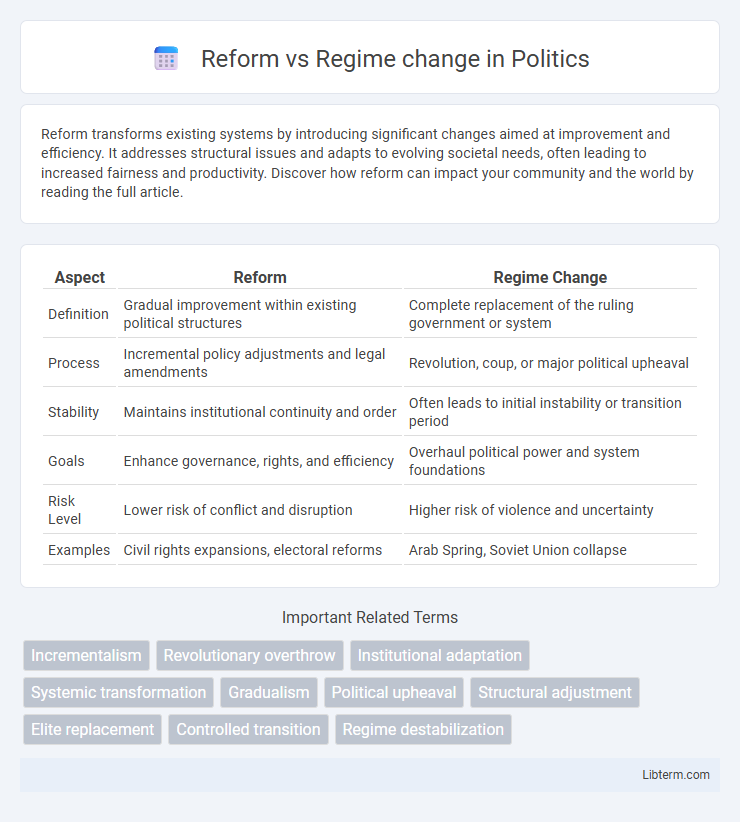Reform transforms existing systems by introducing significant changes aimed at improvement and efficiency. It addresses structural issues and adapts to evolving societal needs, often leading to increased fairness and productivity. Discover how reform can impact your community and the world by reading the full article.
Table of Comparison
| Aspect | Reform | Regime Change |
|---|---|---|
| Definition | Gradual improvement within existing political structures | Complete replacement of the ruling government or system |
| Process | Incremental policy adjustments and legal amendments | Revolution, coup, or major political upheaval |
| Stability | Maintains institutional continuity and order | Often leads to initial instability or transition period |
| Goals | Enhance governance, rights, and efficiency | Overhaul political power and system foundations |
| Risk Level | Lower risk of conflict and disruption | Higher risk of violence and uncertainty |
| Examples | Civil rights expansions, electoral reforms | Arab Spring, Soviet Union collapse |
Understanding Reform and Regime Change
Understanding reform involves gradual, structured improvements within existing political systems aimed at enhancing governance, policies, or social conditions without altering the fundamental power structure. Regime change, by contrast, entails a profound and often abrupt transformation of the ruling authority, frequently involving the replacement of political leaders or the overthrow of governmental frameworks. Distinguishing between these concepts is crucial for analyzing political stability, policy development, and the impacts of governance transitions on society.
Historical Contexts of Political Transformation
Reform refers to gradual political changes implemented within an existing system to improve governance, often seen in the expansion of voting rights during the 19th-century European liberal movements. Regime change involves the complete replacement of a government or political system, exemplified by the Russian Revolution of 1917 which overthrew the Tsarist autocracy and established a communist state. Historical contexts such as colonial independence movements and Cold War-era coups highlight how socio-political pressures and external influences drive either reform or regime change trajectories.
Key Differences: Reform vs. Regime Change
Reform involves targeted adjustments within existing political or social frameworks to improve governance, policies, or institutions without overthrowing the current structure. Regime change entails a complete replacement of the ruling government or system, often through revolution, external intervention, or coup, fundamentally altering political authority and power dynamics. While reform seeks gradual progress and stability, regime change results in abrupt shifts with potentially wide-reaching and unpredictable consequences.
Motivations Behind Reform Movements
Reform movements often arise from public dissatisfaction with economic inequality, lack of political representation, or social injustices, aiming to improve existing systems rather than overthrow them. These motivations include demands for policy changes, increased transparency, and protection of human rights within the current government structure. Contrastingly, regime change is typically driven by deeper systemic failures, authoritarian rule, or widespread corruption, prompting calls for complete political transformation.
Drivers of Regime Change
Drivers of regime change typically include widespread social unrest, economic crises, and loss of legitimacy by the ruling authority. External factors such as foreign intervention and international pressure can accelerate the collapse of a regime. Structural issues like corruption, weak institutions, and lack of political inclusivity further undermine the stability of existing governance systems.
Comparative Case Studies
Comparative case studies of reform versus regime change reveal that reforms often preserve institutional continuity while introducing targeted policy adjustments, as seen in China's gradual economic liberalization. In contrast, regime change typically involves wholesale political system transformation, exemplified by the Arab Spring uprisings, which replaced authoritarian regimes but led to varied outcomes in governance and stability. Analysis highlights that reform tends to be more sustainable in maintaining state capacity, whereas regime change carries higher risks of political instability and institutional fragmentation.
Impact on Political Stability
Reform often preserves political stability by introducing gradual improvements within existing institutions, reducing the risk of abrupt power vacuums or civil unrest. Regime change typically disrupts political equilibrium, frequently leading to transitional instability, power struggles, and potential violence as new authorities consolidate control. Empirical studies highlight that countries undergoing reform tend to experience fewer episodes of state failure compared to those subjected to regime change.
Social and Economic Consequences
Reform leads to gradual social and economic improvements by adjusting existing policies and institutions, preserving stability while addressing inequalities and enhancing public services. Regime change often results in abrupt disruptions, potentially causing economic instability, loss of investor confidence, and social unrest due to power vacuums and policy uncertainty. While reform fosters sustainable development through incremental progress, regime change risks unpredictable outcomes that can hinder long-term social cohesion and economic growth.
International Reactions and Influence
International reactions to reform typically involve cautious support from global organizations and foreign governments emphasizing gradual progress and stability, as seen in the European Union's response to Tunisia's democratic reforms. Regime change often triggers polarized international influence, with some states endorsing intervention and others condemning it as a violation of sovereignty, exemplified by the varied global responses to the 2011 Libya intervention. Both scenarios impact diplomatic relations and foreign aid policies, as countries recalibrate their strategic interests based on the perceived legitimacy and stability of the new leadership.
Choosing the Right Path: Reform or Regime Change
Choosing between reform and regime change hinges on evaluating the stability and responsiveness of existing governance structures. Reform offers gradual improvements within the current system, preserving institutional continuity and minimizing upheaval. Regime change seeks wholesale transformation when entrenched corruption or authoritarianism obstructs progress, though it risks instability and power vacuums.
Reform Infographic

 libterm.com
libterm.com